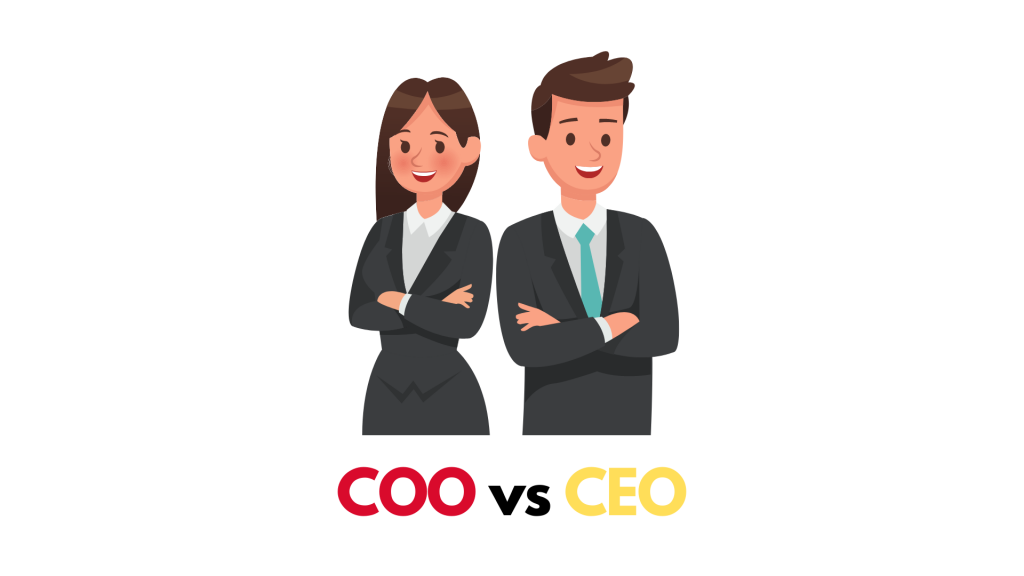The leader of each C suite has its own skills to use in the organization. The two most important top executives are the COO and CEO.
The COO is the Chief Operating Officer responsible for all operations and functions of the company. The COO’s responsibility is to streamline the operations and policies of the organization. The CEO or Chief Executive Officer is the Chief Executive Officer of a company that plans the company’s vision, goals, standards, and processes and is considered to be the highest authority in the company and has a high responsibility for decision making.

In this article, we provide key differences and a comparison chart between a COO vs CEO.
What Does The COO Do?
The Chief Operating Officer (COO) is a C Suite executive who processes and directs the operations and management of the company. The COO is the CEO’s right-hand man who supports the company’s strategy with structured planning. COOs need to motivate different levels of team members to improve operational quality and efficiency.
The COO has the following responsibilities:
- Oversees all internal operations
- Manage and coordinate stakeholders
- Report all important aspects to the CEO
- Analyze business indicators and strategies
- Minimize risk and ensure sector growth
- Monitor various expenses and resources to make sure your budget is met
The Chief Operating Officer (COO) is the executive officer responsible for overseeing the operational functions of a company, including staffing, management, and corporate strategy. The COO, sometimes referred to as the “Executive Vice President of Operations” or “Operations Director,” is often the second chain of command after the Chief Operating Officer.
What Does The CEO Do?
The CEO is a senior C suite executive selected by board members to direct all activities of the company. The CEO is responsible for all strategies and processes. The CEO is the ultimate communicator between teams, leading the company on all key decisions, formulating long-term decisions, managing financial resources and business activities. The CEO, who is the face of the organization, is the person who must be responsible for the overall success or failure of the company.
The CEO’s responsibilities are as follows:
- Creating norms of the corporate culture
- Plan your company’s vision
- Choose what strengthens your company
- Make decisions to move your company’s goals forward
- Become the face of the company at press conferences, exchanges, meetings, etc.
- Present and optimize your business goals and results
- Manage marketing, expansion, messaging, and product roadmap.
The CEO is the primary liaison between senior management and the company’s board of directors, reporting directly to the board of directors on business development issues. In some cases, the CEO may attend the board of directors and serve as chairman. Members of the board determine the responsibilities of the CEO. This includes everything from public relations to overseeing concerns related to an organization’s mission, depending on the size of the company.
Key Differences Between COO vs CEO – Comparison Chart
The main difference between a COO and a CEO is listed below:
| COO (Chief Operating Officer) | CEO (Chief Executive Officer) |
| Handles administrative and operational aspects of the company. | Leads the workforce and handles all the resources. |
| Focuses on optimizing operational efficiency. | Focuses on market capitalization, revenue, stock price, etc. |
| Handles all internal affairs. | Handles both internal and external affairs. |
| Answers to the CEO. | Answers to the board. |
| Is generally paid relative to other C-suite executives. | Is generally paid higher than other C-suite executives. |
| Focuses on short-term planning. | Focuses on long-term planning. |
| Is highly organized, process-driven, analytical and detail-oriented. | Is a solid communicator, leader, and strategist. |
Both the CEO and COO strive to guide and support the growth of the company. The CEO is the chief executive officer of the organization and the COO directs internal operations. The COO’s main goal is to provide services, but the CEO is responsible for the growth of the organization. As companies grow, departmental complexity increases. To close the company gap, you need an expert like the COO. The COO implements the process to meet the changing needs of the business. Both roles are important in achieving the company’s long-term goals and vision.
